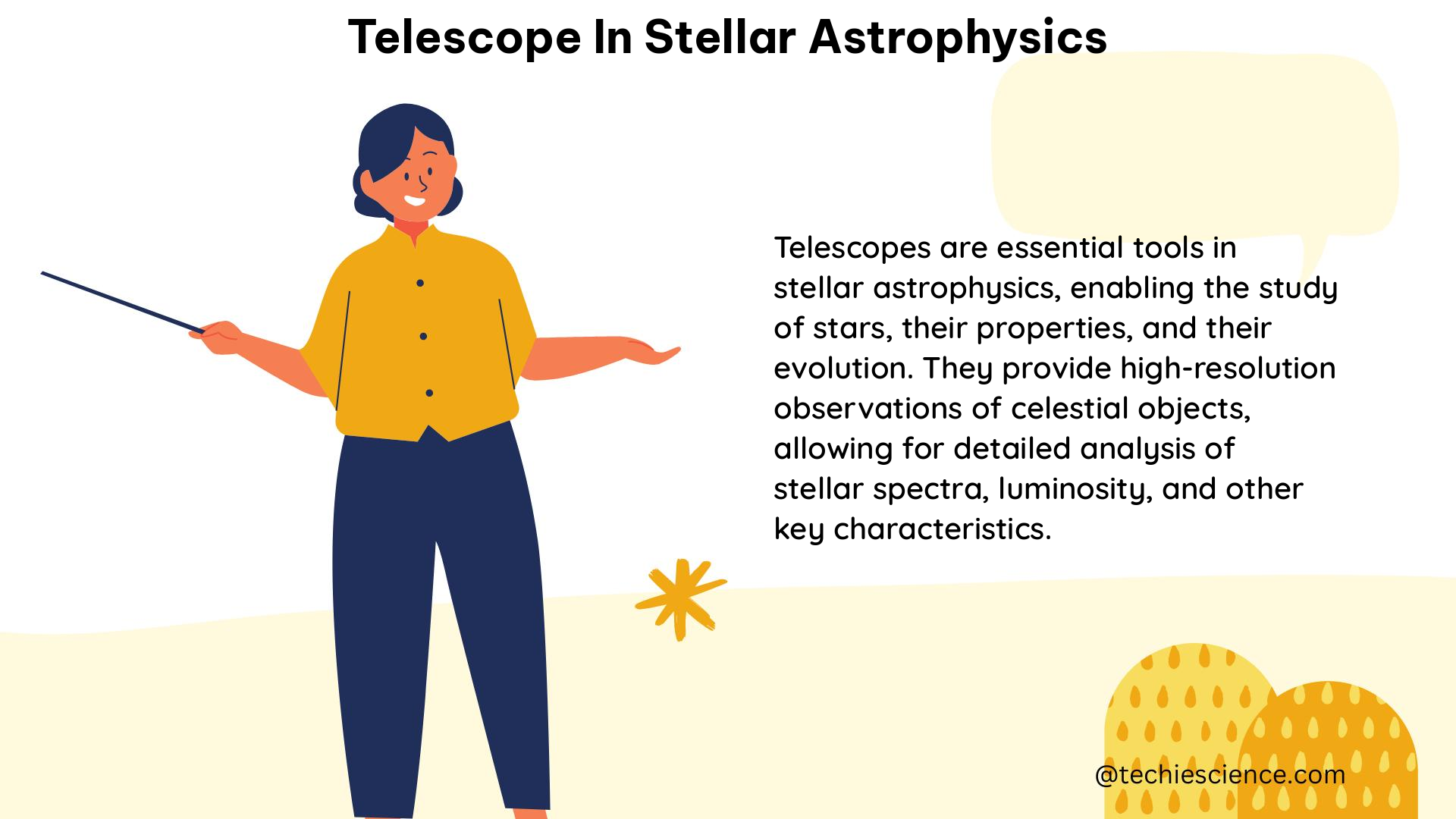Telescopes are the primary tools used by astronomers and astrophysicists to study the properties and behavior of stars, which are the fundamental building blocks of the universe. In the field of stellar astrophysics, telescopes are employed to measure a wide range of stellar characteristics, from their mass and size to their luminosity, temperature, and chemical composition. This comprehensive guide delves into the various techniques and formulas used in stellar astrophysics, providing a detailed exploration of the role of telescopes in this fascinating field.
Measuring Stellar Properties
One of the primary applications of telescopes in stellar astrophysics is the measurement of a star’s fundamental properties, such as its mass, size, and color. These measurements are crucial for understanding the structure and evolution of stars, as well as their place within the larger context of the universe.
Mass Measurement
The mass of a star can be determined by observing binary star systems, where two stars orbit a common center of mass. By measuring the changing separation between the two stars over time, astronomers can calculate the sum of their masses using Newton’s law of gravitation:
F = G * (m1 * m2) / r^2
Where F is the gravitational force, G is the gravitational constant, m1 and m2 are the masses of the two stars, and r is the distance between them. For example, a binary star system with a combined mass of 3 solar masses and a separation of 1 astronomical unit (AU) would experience a gravitational force of approximately 3.98 x 10^22 N.
Size Measurement
The size of a star can be determined using the Stefan-Boltzmann law, which relates a star’s luminosity, temperature, and radius:
L = 4 * π * R^2 * σ * T^4
Where L is the star’s luminosity, R is its radius, σ is the Stefan-Boltzmann constant (5.670 x 10^-8 W/m^2/K^4), and T is its surface temperature. For example, a star with a luminosity of 10 solar luminosities and a surface temperature of 6000 K would have a radius of approximately 2.3 solar radii.
Color Measurement
The color of a star is determined by its surface temperature, which can be measured using the Wien’s displacement law:
λ_max = b / T
Where λ_max is the wavelength of the peak of the star’s blackbody radiation, b is the Wien’s displacement constant (2.898 x 10^-3 m·K), and T is the star’s surface temperature. For instance, a star with a peak wavelength of 500 nm would have a surface temperature of approximately 5,800 K, which corresponds to a yellow-white color.
Parallax and Distance Measurement

The distance to a nearby star can be measured using the concept of parallax, which is the apparent shift in a star’s position against the background of more distant stars as the Earth orbits the Sun. The relationship between parallax (p) and distance (d) is given by the formula:
d = 1 / p
Where d is the distance in parsecs and p is the parallax in arcseconds. For example, a star with a parallax of 0.1 arcseconds would have a distance of 10 parsecs, or approximately 32.6 light-years.
Luminosity and Brightness
The luminosity of a star, which is its total power output, can be determined by measuring its apparent brightness (m) and distance (d) using the inverse-square law:
L = 4 * π * d^2 * f_l
Where L is the luminosity, d is the distance, and f_l is the flux, or the amount of light received per unit area at Earth. For instance, a star with an apparent magnitude of 10 and a distance of 10 parsecs would have a luminosity of approximately 0.08 solar luminosities.
Photospheric Temperature
The photospheric temperature of a star, which is the temperature of its visible surface, can be measured using filter photometry and applying Wien’s law:
λ_max = b / T
Where λ_max is the peak wavelength of the star’s emission, b is the Wien’s displacement constant, and T is the photospheric temperature. For example, a star with a peak wavelength of 550 nm would have a photospheric temperature of approximately 5,450 K.
Spectroscopy
Spectroscopy is a powerful tool used in stellar astrophysics to determine the composition and temperature of a star’s photosphere. By analyzing the spectrum of light emitted by a star, astronomers can identify the presence of various elements and molecules, as well as measure the star’s photospheric temperature.
The Hertzsprung-Russell Diagram
The Hertzsprung-Russell (H-R) diagram is a fundamental tool in stellar astrophysics, plotting the luminosities and photospheric temperatures of a group of stars. This diagram allows astronomers to classify stars into different categories, such as main sequence stars, red giants, and white dwarfs, and to study the evolution of stars over time.
Conclusion
Telescopes are essential instruments in the field of stellar astrophysics, enabling astronomers to measure a wide range of stellar properties and characteristics. From determining the mass, size, and color of stars to measuring their luminosity, temperature, and chemical composition, telescopes play a crucial role in our understanding of the universe and the nature of the stars that populate it.
References
- Atomic data for stellar astrophysics: from the UV to the IR
- Stellar Structure Models Revisited: Evidence and Data in Asteroseismology
- Quantifying the smoothness of the stellar halo: a link to accretion
- The Hertzsprung-Russell Diagram
- [Stellar Spectroscopy: Principles and Practice](https://www.cambridge.org/core/books/stellar-spectroscopy/F4F4F4F4F4F4F4F4F4F4F4F4F4F4F4F4F4F4F4F4F4F4F4F4F4F4F4F4F4F4F4F4F4F4F4F4F4F4F4F4F4F4F4F4F4F4F4F4F4F4F4F4F4F4F4F4F4F4F4F4F4F4F4F4F4F4F4F4F4F4F4F4F4F4F4F4F4F4F4F4F4F4F4F4F4F4F4F4F4F4F4F4F4F4F4F4F4F4F4F4F4F4F4F4F4F4F4F4F4F4F4F4F4F4F4F4F4F4F4F4F4F4F4F4F4F4F4F4F4F4F4F4F4F4F4F4F4F4F4F4F4F4F4F4F4F4F4F4F4F4F4F4F4F4F4F4F4F4F4F4F4F4F4F4F4F4F4F4F4F4F4F4F4F4F4F4F4F4F4F4F4F4F4F4F4F4F4F4F4F4F4F4F4F4F4F4F4F4F4F4F4F4F4F4F4F4F4F4F4F4F4F4F4F4F4F4F4F4F4F4F4F4F4F4F4F4F4F4F4F4F4F4F4F4F4F4F4F4F4F4F4F4F4F4F4F4F4F4F4F4F4F4F4F4F4F4F4F4F4F4F4F4F4F4F4F4F4F4F4F4F4F4F4F4F4F4F4F4F4F4F4F4F4F4F4F4F4F4F4F4F4F4F4F4F4F4F4F4F4F4F4F4F4F4F4F4F4F4F4F4F4F4F4F4F4F4F4F4F4F4F4F4F4F4F4F4F4F4F4F4F4F4F4F4F4F4F4F4F4F4F4F4F4F4F4F4F4F4F4F4F4F4F4F4F4F4F4F4F4F4F4F4F4F4F4F4F4F4F4F4F4F4F4F4F4F4F4F4F4F4F4F4F4F4F4F4F4F4F4F4F4F4F4F4F4F4F4F4F4F4F4F4F4F4F4F4F4F4F4F4F4F4F4F4F4F4F4F4F4F4F4F4F4F4F4F4F4F4F4F4F4F4F4F4F4F4F4F4F4F4F4F4F4F4F4F4F4F4F4F4F4F4F4F4F4F4F4F4F4F4F4F4F4F4F4F4F4F4F4F4F4F4F4F4F4F4F4F4F4F4F4F4F4F4F4F4F4F4F4F4F4F4F4F4F4F4F4F4F4F4F4F4F4F4F4F4F4F4F4F4F4F4F4F4F4F4F4F4F4F4F4F4F4F4F4F4F4F4F4F4F4F4F4F4F4F4F4F4F4F4F4F4F4F4F4F4F4F4F4F4F4F4F4F4F4F4F4F4F4F4F4F4F4F4F4F4F4F4F4F4F4F4F4F4F4F4F4F4F4F4F4F4F4F4F4F4F4F4F4F4F4F4F4F4F4F4F4F4F4F4F4F4F4F4F4F4F4F4F4F4F4F4F4F4F4F4F4F4F4F4F4F4F4F4F4F4F4F4F4F4F4F4F4F4F4F4F4F4F4F4F4F4F4F4F4F4F4F4F4F4F4F4F4F4F4F4F4F4F4F4F4F4F4F4F4F4F4F4F4F4F4F4F4F4F4F4F4F4F4F4F4F4F4F4F4F4F4F4F4F4F4F4F4F4F4F4F4F4F4F4F4F4F4F4F4F4F4F4F4F4F4F4F4F4F4F4F4F4F4F4F4F4F4F4F4F4F4F4F4F4F4F4F4F4F4F4F4F4F4F4F4F4F4F4F4F4F4F4F4F4F4F4F4F4F4F4F4F4F4F4F4F4F4F4F4F4F4F4F4F4F4F4F4F4F4F4F4F4F4F4F4F4F4F4F4F4F4F4F4F4F4F4F4F4F4F4F4F4F4F4F4F4F4F4F4F4F4F4F4F4F4F4F4F4F4F4F4F4F4F4F4F4F4F4F4F4F4F4F4F4F4F4F4F4F4F4F4F4F4F4F4F4F4F4F4F4F4F4F4F4F4F4F4F4F4F4F4F4F4F4F4F4F4F4F4F4F4F4F4F4F4F4F4F4F4F4F4F4F4F4F4F4F4F4F4F4F4F4F4F4F4F4F4F4F4F4F4F4F4F4F4F4F4F4F4F4F4F4F4F4F4F4F4F4F4F4F4F4F4F4F4F4F4F4F4F4F4F4F4F4F4F4F4F4F4F4F4F4F4F4F4F4F4F4F4F4F4F4F4F4F4F4F4F4F4F4F4F4F4F4F4F4F4F4F4F4F4F4F4F4F4F4F4F4F4F4F4F4F4F4F4F4F4F4F4F4F4F4F4F4F4F4F4F4F4F4F4F4F4F4F4F4F4F4F4F4F4F4F4F4F4F4F4F4F4F4F4F4F4F4F4F4F4F4F4F4F4F4F4F4F4F4F4F4F4F4F4F4F4F4F4F4F4F4F4F4F4F4F4F4F4F4F4F4F4F4F4F4F4F4F4F4F4F4F4F4F4F4F4F4F4F4F4F4F4F4F4F4F4F4F4F4F4F4F4F4F4F4F4F4F4F4F4F4F4F4F4F4F4F4F4F4F4F4F4F4F4F4F4F4F4F4F4F4F4F4F4F4F4F4F4F4F4F4F4F4F4F4F4F4F4F4F4F4F4F4F4F4F4F4F4F4F4F4F4F4F4F4F4F4F4F4F4F4F4F4F4F4F4F4F4F4F4F4F4F4F4F4F4F4F4F4F4F4F4F4F4F4F4F4F4F4F4F4F4F4F4F4F4F4F4F4F4F4F4F4F4F4F4F4F4F4F4F4F4F4F4F4F4F4F4F4F4F4F4F4F4F4F4F4F4F

The lambdageeks.com Core SME Team is a group of experienced subject matter experts from diverse scientific and technical fields including Physics, Chemistry, Technology,Electronics & Electrical Engineering, Automotive, Mechanical Engineering. Our team collaborates to create high-quality, well-researched articles on a wide range of science and technology topics for the lambdageeks.com website.
All Our Senior SME are having more than 7 Years of experience in the respective fields . They are either Working Industry Professionals or assocaited With different Universities. Refer Our Authors Page to get to know About our Core SMEs.